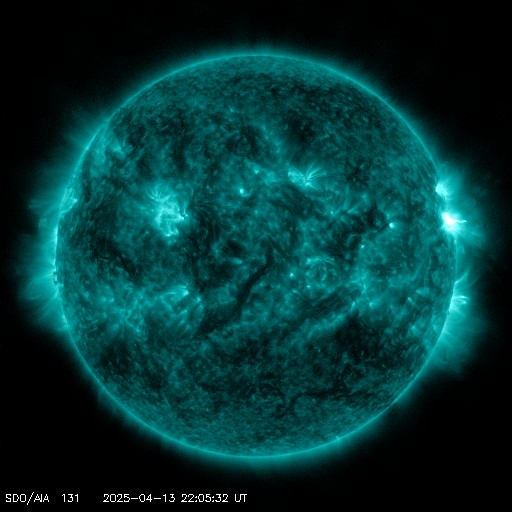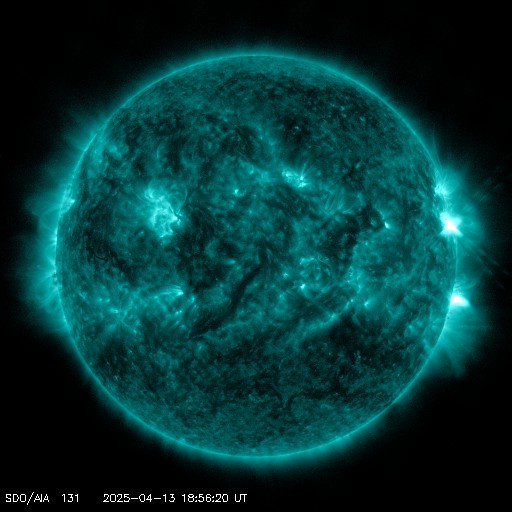Viewing archive of Saturday, 4 February 2023
Daily bulletin on solar and geomagnetic activity from the SIDC
Issued: 2023 Feb 04 1231 UTC
SIDC Forecast
Solar flares
C-class flares expected, (probability >=50%)
Geomagnetism
Quiet (A<20 and K<4)
Solar protons
Quiet
| 10cm flux | Ap | |
|---|---|---|
| 04 Feb 2023 | 137 | 007 |
| 05 Feb 2023 | 137 | 007 |
| 06 Feb 2023 | 137 | 007 |
Bulletin
There are five active regions visible on the solar disc, all of them with simple alpha or beta magnetic field configuration. Solar flaring activity was at low levels over the past 24 hours, with several C-class flares detected. The strongest one was a C2.9 flare from NOAA AR 2307, peaking at 16:30 UTC on 3 February. Further C class flaring is expected.
A wide CME was first seen at 10:36 UTC on 3 February by LASCO C2, with a speed of around 400 km/s, it may arrive to the Earth on 7 February.
The greater than 10 MeV proton flux was at nominal levels in the past 24 hours and is expected to remain so in the next 24 hours. The greater than 2 MeV electron flux has been below the 1000 pfu threshold and is expected to remain so. The 24h electron fluence was at normal levels and is expected to remain so over the next 24 hours.
A negative polarity equatorial coronal crossed the central meridian yesterday, its associated high speed stream will arrive to the Earth in about 2 days.
In the last 24 hours we saw a period of relatively high magnetic field reaching 11 nT with Bz down to -6 nT, probably corresponding to a weak ICME, it ended at 18:00 UTC on 3 February. The solar wind speed at L1 is at 300 km/s with an interplanetary magnetic field around 6 nT, with mostly negative polarity (oriented towards the Sun). Similar conditions can be expected for the next 24 hours.
Geomagnetic conditions were unsettled both locally and at planetary levels (K_Dourbes and Kp up to 3). Similar conditions expected for the next 24 hours.
Today's estimated international sunspot number (ISN): 084, based on 05 stations.Solar indices for 03 Feb 2023
| Wolf number Catania | 085 |
| 10cm solar flux | 135 |
| AK Chambon La Forêt | 017 |
| AK Wingst | 010 |
| Estimated Ap | 009 |
| Estimated international sunspot number | 067 - Based on 17 stations |
Noticeable events summary
| Day | Begin | Max | End | Loc | Strength | OP | 10cm | Catania/NOAA | Radio burst types | |
|---|---|---|---|---|---|---|---|---|---|---|
| None | ||||||||||
Provided by the Solar Influences Data analysis Center© - SIDC - Processed by SpaceWeatherLive
All times in UTC
Current data suggests there is a slight possibility for aurora to appear at the following high latitude regions in the near future
Gillam, MB, Iqaluit, NUNuuk
Reykjavik
Latest news
Latest forum messages
Support SpaceWeatherLive.com!
A lot of people come to SpaceWeatherLive to follow the Sun's activity or if there is aurora to be seen, but with more traffic comes higher server costs. Consider a donation if you enjoy SpaceWeatherLive so we can keep the website online!

Latest alerts
Sunday, 13 April 2025
22:21 UTC - Solar flare
Moderate M1.66 flare from sunspot region 4055
22:03 UTC - Radio Blackout
Minor R1 radio blackout in progress (≥M1 - current: M1.01)
20:48 UTC - Hemispheric Power Index
The OVATION model predicts the Hemispheric Power Index to reach 50GW at 21:39 UTC
19:09 UTC - Solar flare
Moderate M3.24 flare from sunspot region 4055
18:51 UTC - Radio Blackout
Minor R1 radio blackout in progress (≥M1 - current: M1.07)
Space weather facts
| Last X-flare | 2025/03/28 | X1.1 |
| Last M-flare | 2025/04/13 | M1.6 |
| Last geomagnetic storm | 2025/04/06 | Kp5 (G1) |
| Spotless days | |
|---|---|
| Last spotless day | 2022/06/08 |
| Monthly mean Sunspot Number | |
|---|---|
| March 2025 | 134.2 -20.4 |
| April 2025 | 136.4 +2.2 |
| Last 30 days | 134.2 -8.9 |




